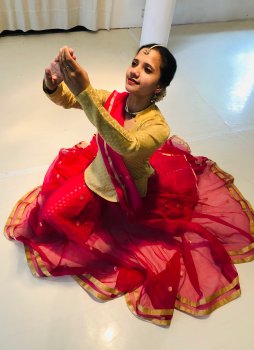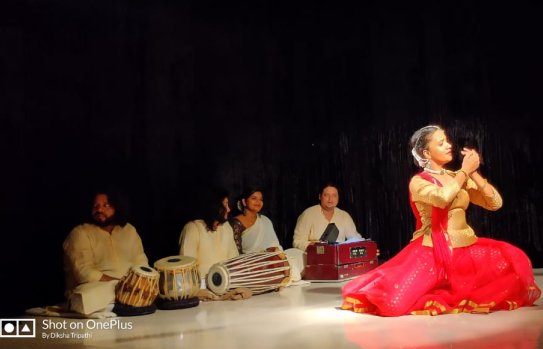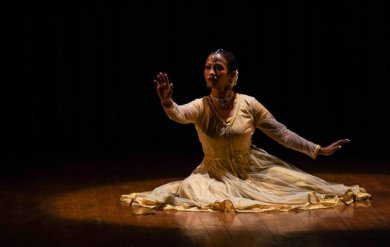
|   |

|   |
 e-mail: leelakaverivenkat@gmail.com October features varying manifestations of dance November 7, 2019 Indo-American Friendship Association, initiated by Ambassador Surendra Kumar as "non-profit, non-political, non-religious, non-sectarian, and non-commercial" to enlarge the horizon of friendship and understanding between India and the US, featured on October 9 at Habitat's Stein auditorium an evening of dancers trained under three stalwarts of dance, Pt Birju Maharaj, Sonal Mansingh and Saroja Vaidyanathan representing the traditions of Kathak, Odissi and Bharatanatyam respectively. Surendra Kumar's introductory words referring to the gurus as "true inheritors of renowned legacies," also in passing mentioned arranging the coming together of three known Gurus as being one of the most difficult objectives to have achieved - of all his programs so far arranged. With firm politeness, denying the veracity of this statement, Sonal Mansingh called the Gurus an easy people to deal with - and one needing all the support which now was going to areas which were affluent and were flourishing and did not need any outside support. Under the guidance of Odissi guru Sonal Mansingh, it was Chandrashekar Sutar who first took the floor with Nataraj Tanaya, a composition of Mangala Prasad, with intermingling of nritta and abhinaya creating a fine lasya/tandava blend. As homage to Ganesh, the Vidyadhara, the composition revels in saluting Ganesh as the brother of Kartikeya, and son of Shiva, the Natasundara, adorned by the snake. The typical Odisha flavor in the music in vilambit allows leisurely treatment of the expressional parts, with drut vivacity also featured in the punctuational nritta passages. The next composition, designed as a 'musical dance drama' was in a totally contrasting mood with no hint of tandav vigour. An old Samantha Singhar composition "Brindavane Ke Bansi Bajaila", the composition is so designed that Krishna, the charmer with the flute, appears in the second half in the midst of the graceful Gopis (played by Karishma, Srishita, Jigyassa, Mansi and Nivedita). In its total lasya orientation, even Krishna (Chandrakant Sutar) who enters in the latter half is all soft dance and grace. The strong point of Saroja Vaidyanathan's Ganesha Natyalaya Bharatanatyam students lay in their commendable combined strength - the sense of oneness and group coordination standing out. Starting with two lines from the Angikam Bhuvanam verse of the Abhinaya Darpana, and homage to the Guru who is elevated to Brahma, Vishnu and Shiva, (the accompanying music in Mohanam) the uniformly held full hand stretches, articulated araimandi, neck and eye movements and verve in the dancing made a strong impression. The dancers costumed in a blend of the colours of the Indian flag (white and green with orange blouse) ended in a fine group freeze. The assertive movement style, with strong lines, also went very well with the sahitya of Subramania Bharatiyar's poetry. Making Nature an allegory for the lusty triumphant sounds of freedom, "Dikkugal yettum sidhari" the poem describes Nature's orchestration of acts for freedom strong enough for all the eight directions to be shattered - water torrentially rushing down the mountains, the skies rent with lightning and rolling thunder as if clapping in myriad rhythms, Earth shaking in all sides in a lusty call for a free Motherland. What a blessing to be able to see this happening in front of one's eyes! Very much in the patriotic mood, the group went on to yet another Bharatiyar composition, "Vidudalai! Vidudalai! Vidudalai!" (Freedom, Freedom, Freedom), this time the freedom being for eradicating societal ills like poverty, all forms of exploitation, caste barriers and dowry demands. The involved presentation ended with Devi Shakti - a short prayer to Devi during the Navaratri Season. The finale of Kathak was by the students of Kalashram, the institution of Pandit Birju Maharaj. With Saswati Sen in a minimal appearance setting off the evening well trained, richly costumed dancers greeted the arrival of Spring, "Ritu Aavana Ritu Vasanta". Taal Tarang, a composition of Birju Mahraj, saw ginti tihais and pirouettes at full speed, a delight to watch. While the girls shone in folds of the graceful fall of sky blue ghagras, the top coat of the male dancers in a darker hued blue with large prints, seemed somewhat loud. On the whole, it was a colourful evening of dance of different dance manifestations. Drishtikon's Home- Studio Baithak Season VI Photos: Team Drishtikon  
Tripti Gupta
Drishtikon's Home- Studio Baithak Season VI as an opportunity for young performers to showcase their talent, was an eye opener for me. Reaching the Studio is like undertaking a trek through the Himalayas, plying through the myriad narrow lanes of Sainik Farm area wondering if the slow progress through pot holed roads will end. And then like "Jungle mein Mangal" as the Hindi saying goes, one comes across this tastefully built space with a group of eager eyed people waiting to offer you their welcome and you are overtaken by the enthusiastic atmosphere all round. And the dance by Tripti Gupta proved the icing on the cake. Tripti Gupta, now under the guidance of Aditi Mangaldas and Drishtikon as a member of its Repertory, was brought up in Sagar of Madhya Pradesh. Academically brilliant, she had her Kathak training under Ragini Srivastava going on to complete her Masters in Kathak with a gold medal. Conferred Rashtriya Dance Festival Balashree Samman by the National Bal Bhavan, Government of India and New Delhi, joining the Drishtikon Dance Foundation Repertory in 2017 after being auditioned, she is showing signs of being one of the most promising of upcoming Kathak dancers. Conceived and worked out by Ragini Srivastava and Tripti Gupta, the solo presentation Tripti gave was one of the most finished one has experienced from a young dancer - her entire treatment woven round the love theme conceived by Sahir, set to music by Mohit Gangani (tabla), Ashish Gangani (pakhawaj), and Faraz Ahmed providing vocal music and harmonium and Anjana Singh providing padhant. Tripti turned out in a very aesthetic getup designed by Guru Ragini Srivastava, danced with a confidence and involvement which spoke for themselves. The dove-tailing of all intra-forms of Kathak nritta as punctuation points in the performance reinforcing the main theme, made pure dance and interpretative dance part of one complete mesh. "Kaga saptan khaayo, chun chun kaiyo ma, mohe priya milan ki yaad..." A delectable blend of assertion and grace, for me the way the accented and unaccented syllables of rhythm spoke through the footwork and the utter grace of the Gath with eyes creating all the bhav, spoke of the complete understanding of movement to mood. And even more pleasing aspect was the conviction in softness, without highly inflated sound, with percussion instruments and singing never taking recourse to high decibel levels. Percussion also has to create melody through bols - not just the arithmetic of rhythmic wizardry. The unusual aspect of the evening for this critic was the blend of different aptitudes, specializations and points of view coming together in a dance institution. The jostling of ideas and perspectives that such mingling can create is one of the best ways of encouraging creativity which avoids the stereotypical patterns. There was the artistic installation made of fiberglass and lit from within, in a corner of the small lawn by Gaurav Bhatti from Canada, the youngster, apart from having a full-fledged degree in the arts, also a very keen Kathak student.  Saattvic Then came Saattvic, an actor involved with school and children's theatre who apart from attending workshops by Barry John, Zarin Chaudhary and directing theatre ventures, is a tabla player having been trained for 9 years under Ashok Moitra in the Benares gharana and having also learnt Hindustani classical music at the Gandharva Mahavidyalaya and at school from Baisakhi Samajdhar. Above all these qualifications, he is an M Phil in Economics from Oxford University and his specialization is Competition Economics being informed with several high-profile mergers. And 'Natyothpatte Katha' he presented in the latter part of the evening was a kind of spoof on the Natya Sastra. Over 21 lakh years ago, the advent of the Treta Yuga, after the end of the Satya Yuga, saw a decay in humanity with undesirable qualities of kama, krodh, lobha, mada etc taking over and the Yakshas and Gandharvas approached Brahma, the creator, to create some means of taking the best of our Vedas to humanity so as to elevate the quality of Man. So Brahma created the Natya Veda, a blend of various aspects taken out of each of the Vedas, to create the fifth Veda. And it was given to Bharata Muni to be spread amongst his sons and the world's first play was created, with all the disruption by the Asuras. Clad in a dhoti, the story teller Saattvic, started narrating from what obviously must have been his own script, with its regaling moments of laughter and heightened tension flowing from the way contemporary societal developments were touched upon - from intolerance, lack of individual freedom to caste and religious divisions etc. Heightening the impact with punctuation points was a passing tabla solo knitting permutations and combinations into the recorded lehra musical refrain, and a short spurt of his own singing. Rather than guffaws, little titters and smiles showed that the audience was in full appreciation. It was a small gathering, but with the right atmosphere for art creativity. Triya -A good try Photo: Aashray Kohli Aditi Mangaldas Dance Company presented Dance Drishtikon in Triya, a new work envisioned in a novel way wherein the dancer Anindita Acharjee had each of the four segments of the production, designed by young choreographers Drishtikon believes in providing opportunities to. The entire theme was an attempt at exploring the inner self of a woman and what she is. Does woman consider herself to be Radha, Meera, Ahalya or just somebody with one's own identity? Is she beautiful, cursed or on the contrary free to take her own decisions in life? Has she the courage to choose what her innermost self desires, or is she bound by society?  Anindita Acharjee The opening scene Shyama, choreographed by Gauri Diwakar, pondered on the nature of a woman's beauty. If beauty is but His manifestation, how does one regard it - as a subsidiary aspect and only a facet of the Supreme being? Does woman's beauty pale even the moon and sun in comparison? In Gauri's choreography the idea of just beauty, got reflected even in a Gat. Adorning herself "Sundara vadanaambara vadana..." woman sets out, even the moon asking her to cover herself with a veil for so dazzling is her beauty. The choreography used poetry of Vidyapati whose sringar verses were all strung round the Radha and Krishna theme. In the Jeevatma / Paramatma interaction, if the micro is but a part and reflection of the macro in the Universe, then what is the relationship between Radha and Krishna? The entire dance tapestry of abhinaya moving on to nritta punctuations which even in rhythm heightened the tone of the emotive part, was elegantly composed and the dancer, rhythmically immaculate even in the softness of grace, did well. But what this critic found lacking was that the idea of woman pondering over her identity asking herself "What am I?" needed more emphasis. Gowri's well articulated padhant had Samiullah Khan for music composition and as singer, percussionists Yogesh Gangani and Mahaveer Gangani on tabla and pakhawaj and Kiran Kumar on flute. Choreographic honours for the day certainly belonged to young choreographer Dhirendra Tiwari whose conceptualization of Ahalya was truly innovative. Set to 10 matras (but not jhaptal) the way words were strung in a chhand in Kavit like fashion (text by Ghulab Khandelwal and Dheerendra), the Ginti tihai in multiples of 5, and how the khanda jati in the narrative was set, showed fine feel for laya and its quality in evoking a mood. Waiting for years for Lord Rama to redeem her, Ahalya had a raw deal. Expectations being constantly denied, did she deserve to be punished so cruelly, by being turned into a stone? Did she as woman have no right to her desires being fulfilled? And the gradual process whereby Ahalya loses her ability to move to finally become totally immovable was very well brought out in the choreography. Dheerendra seems to have great talent and what is more his visualization included the interpretative along with the rhythmic. Shyama-Mayee, the next episode, was on a woman like Meera with her single minded devotion to Krishna - with her fixed aim by becoming one with Krishna, she had the courage to tear herself away from the shackles of aristocracy to which she was born and also wed. For her giving up all the wealth was freedom. Meera symbolizes woman who will break through the worst type of binds imposed by traditional society to choose her own path. In "Suno Ranaji" she addresses her princely husband. All ornaments for her were jagmag (idle glitter) which had to be shed. "Sach Hari ki preet hai," she says. The agitations shown through just solfa syllables, showing Meera standing unaffected even after drinking the cup of poison sent by the Rana himself, would all have been effective if the choreographer Rachana Yadav's padhant had been audible and recited to proper laya. One wonders if she was not able to hear the percussionists clearly - because what she uttered and the laya set seemed at cross purposes. So what is woman - a blend of the beauty of Radha, the desires of Ahalya, the indomitable courage of Meera? She has her emotions, her identity - She cannot be made to order. This part was in words read by Gowri as the dancer through interpretative dance showed how like Nature with all her variety, she too has her beauty, her body, her emotions, the tika on her forehead, the anklets on her feet - why does she have to keep listening? She has the freedom to express herself. I have a mind which experiences and has its own thoughts. Anindita is a very promising dancer and took up the challenge of dancing what others had visualized.  Writing on the dance scene for the last forty years, Leela Venkataraman's incisive comments on performances of all dance forms, participation in dance discussions both in India and abroad, and as a regular contributor to Hindu Friday Review, journals like Sruti and Nartanam, makes her voice respected for its balanced critiquing. She is the author of several books like Indian Classical dance: Tradition in Transition, Classical Dance in India and Indian Classical dance: The Renaissance and Beyond. Post your comments Please provide your name and email id when you use the Anonymous profile in the blog to post a comment. All appropriate comments posted with name and email id in the blog will also be featured in the site. |